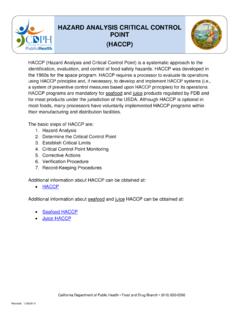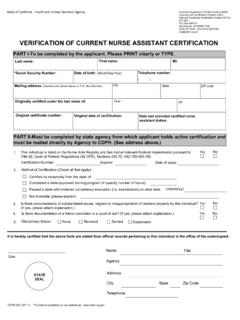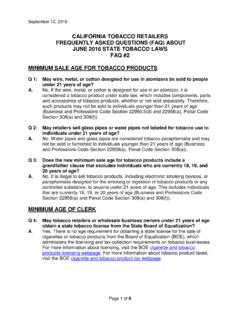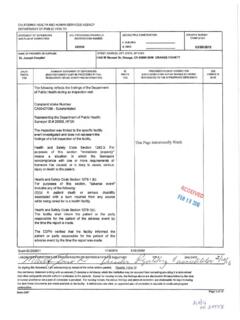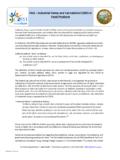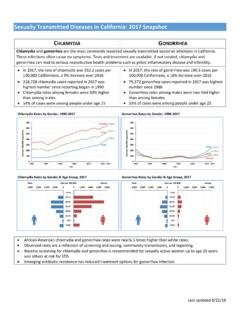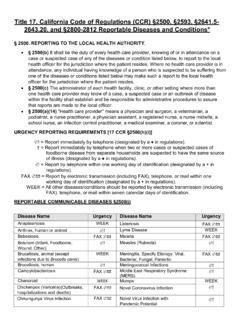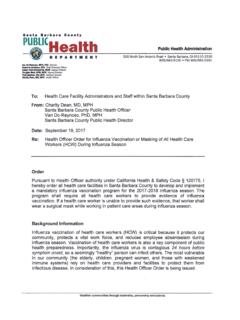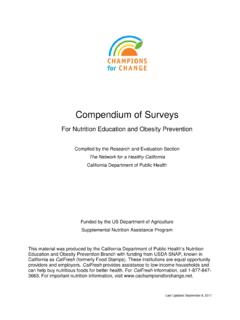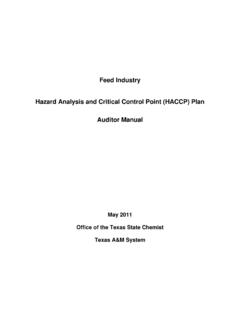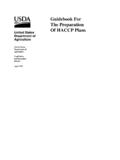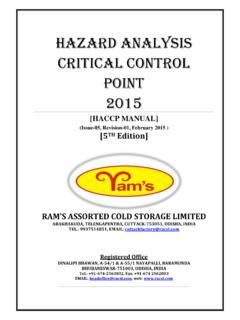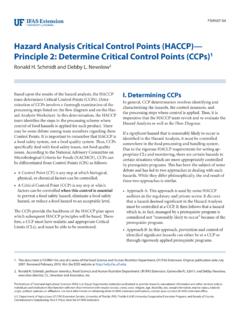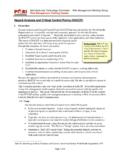Transcription of PART 120 -- HAZARD ANALYSIS AND CRITICAL CONTROL …
1 Code of Federal Regulations TITLE 21--FOOD AND DRUGS PART 120 -- HAZARD ANALYSIS AND CRITICAL CONTROL POINT (HACCP) SYSTEMS Subpart A--General Provisions Applicability. Definitions. Current good manufacturing practice. Sanitation standard operating procedures. HAZARD ANALYSIS . HAZARD ANALYSIS and CRITICAL CONTROL Point (HACCP) plan. Legal basis. Corrective actions. Verification and validation. Records. Training. Application of requirements to imported products. Subpart B--Pathogen Reduction General. Process controls. Process verification for certain processors. Authority: 21 321, 342, 343, 346, 348, 371, 374, 379e, 381, 393; 42 241, 242l, 264. Subpart A--General Provisions Sec. Applicability. (a) Any juice sold as such or used as an ingredient in beverages shall be processed in accordance with the requirements of this part.
2 Juice means the aqueous liquid expressed or extracted from one or more fruits or vegetables, purees of the edible portions of one or more fruits or vegetables, or any concentrates of such liquid or puree. The requirements of this part shall apply to any juice regardless of whether the juice, or any of its ingredients, is or has been shipped in interstate commerce (as defined in section 201(b) of the Federal Food, Drug, and Cosmetic Act, 21 321(b)). Raw agricultural ingredients of juice are not subject to the requirements of this part. Processors should apply existing agency guidance to minimize microbial food safety hazards for fresh fruits and vegetables in handling raw agricultural products. (b) The regulations in this part shall be effective January 22, 2002. However, by its terms, this part is not binding on small and very small businesses until the dates listed in paragraphs (b)(1) and (b)(2) of this section.
3 (1) For small businesses employing fewer than 500 persons the regulations in this part are binding on January 21, 2003. (2) For very small businesses that have either total annual sales of less than $500,000, or if their total annual sales are greater than $500,000 but their total food sales are less than $50,000; or the person claiming this exemption employed fewer than an average of 100 full-time equivalent employees and fewer than 100,000 units of juice were sold in the United States, the regulations are binding on January 20, 2004. Sec. Definitions. The definitions of terms in section 201 of the Federal Food, Drug, and Cosmetic Act, (j)(18)(vi), and part 110 of this chapter are applicable to such terms when used in this part, except where redefined in this part. The following definitions shall also apply: (a) Cleaned means washed with water of adequate sanitary quality. (b) CONTROL means to prevent, eliminate, or reduce.
4 (c) CONTROL measure means any action or activity to prevent, reduce to acceptable levels, or eliminate a HAZARD . (d) CRITICAL CONTROL point means a point, step, or procedure in a food process at which a CONTROL measure can be applied and at which CONTROL is essential to reduce an identified food HAZARD to an acceptable level. (e) CRITICAL limit means the maximum or minimum value to which a physical, biological, or chemical parameter must be controlled at a CRITICAL CONTROL point to prevent, eliminate, or reduce to an acceptable level the occurrence of the identified food HAZARD . (f) Culled means separation of damaged fruit from undamaged fruit. For processors of citrus juices using treatments to fruit surfaces to comply with , culled means undamaged, tree-picked fruit that is Department of Agriculture choice or higher quality. (g) Food HAZARD means any biological, chemical, or physical agent that is reasonably likely to cause illness or injury in the absence of its CONTROL .
5 (h) Importer means either the owner or consignee at the time of entry of a food product into the United States, or the agent or representative of the foreign owner or consignee at the time of entry into the United States. The importer is responsible for ensuring that goods being offered for entry into the United States are in compliance with all applicable laws. For the purposes of this definition, the importer is ordinarily not the custom house broker, the freight forwarder, the carrier, or the steamship representative. (i) Monitor means to conduct a planned sequence of observations or measurements to assess whether a process, point, or procedure is under CONTROL and to produce an accurate record for use in verification. (j) (1) Processing means activities that are directly related to the production of juice products. (2) For purposes of this part, processing does not include: (i) Harvesting, picking, or transporting raw agricultural ingredients of juice products, without otherwise engaging in processing; and (ii) The operation of a retail establishment.
6 (k) Processor means any person engaged in commercial, custom, or institutional processing of juice products, either in the United States or in a foreign country, including any person engaged in the processing of juice products that are intended for use in market or consumer tests. (l) Retail establishment is an operation that provides juice directly to the consumers and does not include an establishment that sells or distributes juice to other business entities as well as directly to consumers. "Provides" includes storing, preparing, packaging, serving, and vending. (m)Shall is used to state mandatory requirements. (n) Shelf-stable product means a product that is hermetically sealed and, when stored at room temperature, should not demonstrate any microbial growth. (o) Should is used to state recommended or advisory procedures or to identify recommended equipment. (p) Validation means that element of verification focused on collecting and evaluating scientific and technical information to determine whether the HACCP plan, when properly implemented, will effectively CONTROL the identified food hazards .
7 (q) Verification means those activities, other than monitoring, that establish the validity of the HACCP plan and that the system is operating according to the plan. Sec. Current good manufacturing practice. Part 110 of this chapter applies in determining whether the facilities, methods, practices, and controls used to process juice are safe, and whether the food has been processed under sanitary conditions. Sec. Sanitation standard operating procedures. (a) Sanitation controls. Each processor shall have and implement a sanitation standard operating procedure (SSOP) that addresses sanitation conditions and practices before, during, and after processing. The SSOP shall address: (1) Safety of the water that comes into contact with food or food contact surfaces or that is used in the manufacture of ice; (2) Condition and cleanliness of food contact surfaces, including utensils, gloves, and outer garments; (3) Prevention of cross contamination from insanitary objects to food, food packaging material, and other food contact surfaces, including utensils, gloves, and outer garments, and from raw product to processed product; (4) Maintenance of hand washing, hand sanitizing, and toilet facilities; (5) Protection of food, food packaging material, and food contact surfaces from adulteration with lubricants, fuel, pesticides, cleaning compounds, sanitizing agents, condensate, and other chemical, physical, and biological contaminants; (6) Proper labeling, storage, and use of toxic compounds.
8 (7) CONTROL of employee health conditions that could result in the microbiological contamination of food, food packaging materials, and food contact surfaces; and (8) Exclusion of pests from the food plant. (b) Monitoring. The processor shall monitor the conditions and practices during processing with sufficient frequency to ensure, at a minimum, conformance with those conditions and practices specified in part 110 of this chapter that are appropriate both to the plant and to the food being processed. Each processor shall correct, in a timely manner, those conditions and practices that are not met. (c) Records. Each processor shall maintain SSOP records that, at a minimum, document the monitoring and corrections prescribed by paragraph (b) of this section. These records are subject to the recordkeeping requirements of (d) Relationship to HAZARD ANALYSIS and CRITICAL CONTROL Point (HACCP) plan.
9 Sanitation standard operating procedure controls may be included in the HACCP plan required under (b). However, to the extent that they are implemented in accordance with this section, they need not be included in the HACCP plan. Sec. HAZARD ANALYSIS . (a) Each processor shall develop, or have developed for it, a written HAZARD ANALYSIS to determine whether there are food hazards that are reasonably likely to occur for each type of juice processed by that processor and to identify CONTROL measures that the processor can apply to CONTROL those hazards . The written HAZARD ANALYSIS shall consist of at least the following: (1) Identification of food hazards ; (2) An evaluation of each food HAZARD identified to determine if the HAZARD is reasonably likely to occur and thus, constitutes a food HAZARD that must be addressed in the HACCP plan. A food HAZARD that is reasonably likely to occur is one for which a prudent processor would establish controls because experience, illness data, scientific reports, or other information provide a basis to conclude that there is a reasonable possibility that, in the absence of those controls, the food HAZARD will occur in the particular type of product being processed.
10 This evaluation shall include an assessment of the severity of the illness or injury if the food HAZARD occurs; (3) Identification of the CONTROL measures that the processor can apply to CONTROL the food hazards identified as reasonably likely to occur in paragraph (a)(2) of this section; (4) Review of the current process to determine whether modifications are necessary; and (5) Identification of CRITICAL CONTROL points. (b) The HAZARD ANALYSIS shall include food hazards that can be introduced both within and outside the processing plant environment, including food hazards that can occur before, during, and after harvest. The HAZARD ANALYSIS shall be developed by an individual or individuals who have been trained in accordance with and shall be subject to the recordkeeping requirements of (c) In evaluating what food hazards are reasonably likely to occur, consideration should be given, at a minimum, to the following: (1) Microbiological contamination; (2) Parasites; (3) Chemical contamination; (4) Unlawful pesticides residues; (5) Decomposition in food where a food HAZARD has been associated with decomposition; (6) Natural toxins; (7) Unapproved use of food or color additives; (8) Presence of undeclared ingredients that may be allergens; and (9) Physical hazards .
